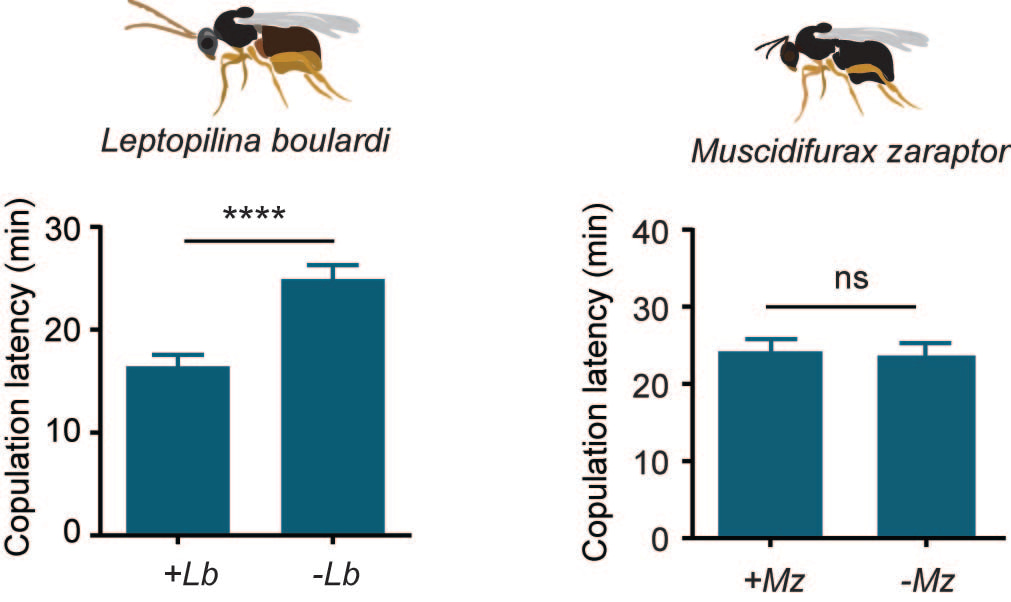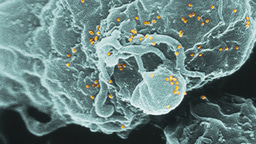Sight of parasitoid wasps accelerates sexual behavior and upregulates a micropeptide gene in Drosophila
Published in Ecology & Evolution
About 350,000 species of parasitoid wasps, insects whose larvae live as parasites that eventually kill their hosts, inhabit the natural world. Parasitoid wasps exert selective pressure on insects including Drosophila of which 80% of their larvae in nature are killed by these parasitoid wasps. (1) In turn, Drosophila adults and larvae have evolved a variety of defenses against parasitoid wasps, including:
- encapsulating the wasp egg with hemocytes and melanin in attacked larvae. (2)
- Rolling the attacking wasp by larvae to flip the wasp and end the attack. This rolling behavior is controlled by a multimodal circuit involving mechanosensory and nociceptive neurons. (3,4)
- Reducing the number of laid eggs and preferring to oviposit in food containing toxic levels of alcohol by gravid Drosophila when seeing the parasitoid wasps. (5)
- Avoiding oviposition sites that contain the smell of parasitoid wasps by gravid Drosophila. This avoidance behavior is mediated by a specific olfactory receptor neuron that expresses the odorant receptors, Or49a and Or85f, which selectively respond to Leptopilina (6)
After publishing my Ph.D. paper on avoiding parasitoid wasps by Drosophila adult and larvae via sensing their semiochemicals, what has remained to investigate is whether exposure to parasitoid wasps affects one of the most evolutionary ancient, fundamental, and robust of all Drosophila behaviors: mating behavior.
I completed my graduate work under the supervision of Drs. Bill S. Hansson and Markus Knaden at Max Planck Institute for Chemical Ecology, Jena, Germany, and moved to Yale University to join John Carlson's lab. Here I convinced Dr. John to pursue a project to find whether the mating of male and female fruit flies would be affected by the presence of parasitoid wasps.
 Fig 1: Courtship arena.
Fig 1: Courtship arena.
We immediately contacted Dr. Todd Schlenke at the University of Arizona, and he willingly agreed to provide us with different parasitoid wasps that attack Drosophila larvae or pupae.
In the beginning, we expected that the presence of parasitoid wasps stops or delays mating. Surprisingly, flies mate quicker in the presence of parasitoid wasps (Fig. 1). The acceleration of mating upon seeing parasitoid wasps is conserved in multiple Drosophila species, which occupy diverse habitats and have different relations to each other. This effect is also induced by several wasps that parasitize Drosophila (e.g., Leptopilina boulardi, Lb) (Fig. 2a). Parasitoid wasps that do not parasitize Drosophila, such as Muscidifurax zaraptor (Mz), do not change Drosophila mating (Fig. 2b).
 Fig 2: Copulation latency of D. melanogaster in presence of Lb (a) and Muscidiflurax zaraptor (b).
Fig 2: Copulation latency of D. melanogaster in presence of Lb (a) and Muscidiflurax zaraptor (b).
In the beginning, we hypothesized that the wasps that affected mating produce an odor and that this odor activates an olfactory circuit that accelerates sexual behavior. Surprisingly, olfactory-impaired flies still show an acceleration in mating onset following exposure to parasitoid wasps, suggesting the acceleration of mating upon seeing parasitoid wasp does not require olfaction.
Although the focus of Carlson Lab is insect chemoreception, Dr. John supported and encouraged me to further test the hypothesis that the effect of wasps on fly mating behavior is mediated by vision.
In dim red light, to which Drosophila has very low sensitivity, copulation latency of wild-type flies is not affected by the presence of any species of wasps. Likewise, mutant flies lacking a critical photoreceptor gene, ninaB, show equivalent copulation latency in the presence and absence of parasitoid wasps. Furthermore, flies in which certain visual system projection neurons (LC4) are blocked do not copulate faster anymore when exposing to parasitoid wasps. Together, these results demonstrate that the acceleration of mating upon seeing parasitoid wasps depends on vision.
I next asked if visual contact with wasps changes the expression levels of certain genes. With the help of Dr. Gaelle Talross, an expert in molecular biology, we carried out a differential RNA-seq analysis of the heads of female flies that had been exposed to parasitoid wasps, and heads of unexposed females. Interestingly, the visual contact with wasps induces the 20X upregulation of a micropeptide gene, IBIN, which encodes a micropeptide of 41 amino acids, in the nervous system: eyes, optic lobes, and other brain tissues. Strikingly, social isolation and infection also increase the expression of this gene in immune-responsive tissues, including hemocytes and the fat body. Perhaps, the IBIN micropeptide represents a new link between the nervous system and immune system.
Blockage of LC4 neurons eliminates the increase of IBIN induced by exposure to parasitoid wasps, consistent with its inhibition of the behavioral effect. CRISPR mutant flies of IBIN do not show the expected acceleration in mating behavior upon seeing parasitoid wasps.
our work illuminates a problem of immense significance in the natural world that is severely understudied. It identifies an unexpected form of behavioral plasticity, and it reveals a novel role for a micropeptide gene.
This work has relevance to the control of agricultural pests and insect disease vectors: parasitoid wasps have proven remarkably useful in controlling invasive pest species. Often the most effective means of controlling an invasive pest is to identify and import a parasitoid wasp that controls it in its native environment.
Citations
Behind the Paper: Ebrahim S.A.M. et al.. Sight of parasitoid wasps accelerates sexual behavior and upregulates a micropeptide gene in Drosophila. Nature communications. (2021).
- Fleury F, Ris N, Allemand R, Fouillet P, Carton Y, Bouletreau M. Ecological and genetic interactions in Drosophila-parasitoids communities: a case study with D. melanogaster, D. simulans and their common Leptopilina parasitoids in south-eastern France. Genetica 120, 181-194 (2004).
- Lemaitre B, Hoffmann J. The host defense of Drosophila melanogaster. Annu Rev Immunol 25, 697-743 (2007).
- Hwang RY, et al. Nociceptive neurons protect Drosophila larvae from parasitoid wasps. Curr Biol 17, 2105-2116 (2007).
- Robertson JL, Tsubouchi A, Tracey WD. Larval defense against attack from parasitoid wasps requires nociceptive neurons. PLoS One 8, e78704 (2013).
- Kacsoh BZ, Lynch ZR, Mortimer NT, Schlenke TA. Fruit flies medicate offspring after seeing parasites. Science 339, 947-950 (2013).
- Ebrahim SA, et al. Drosophila Avoids Parasitoids by Sensing Their Semiochemicals via a Dedicated Olfactory Circuit. PLoS Biol 13, e1002318 (2015).
Follow the Topic
-
Nature Communications

An open access, multidisciplinary journal dedicated to publishing high-quality research in all areas of the biological, health, physical, chemical and Earth sciences.
Related Collections
With Collections, you can get published faster and increase your visibility.
Clinical trials 2025
Publishing Model: Open Access
Deadline: Dec 31, 2025
Women's Health
Publishing Model: Hybrid
Deadline: Ongoing



Please sign in or register for FREE
If you are a registered user on Research Communities by Springer Nature, please sign in